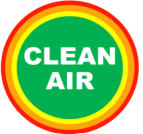
Is the Particulate Matter Exposure a Health Threat on the Nipomo Mesa?
The dust plume that arises on windy days from the the Oceano Dunes State Vehicular Recreation Area (SVRA) regularly exceeds State standards for particulate matter (PM) concentrations. Release of fine particulate matter into the air is regulated by Federal and California law because PM exposure is proven to be a health risk. California air quality standards set limits on maximum emission levels for particles that are 10 microns per cubic meter (PM10) and 2.5 microns per cubic meter (PM2.5). When people breathe air that contains fine particles of this size, some of the particles stay in their lungs and the smallest particles can pass through the lungs into the blood stream. Being exposed to any kind of particulate matter may cause: • increased emergency department visits and hospital stays for breathing and heart problems • worsened asthma symptoms • adverse birth outcomes • breathing problems • decreased lung growth in children • lung cancer • early deaths People who are at the highest risk of being adversely affected by particulate matter include: • People with heart or lung diseases , because they will feel the effects of particulate matter sooner. • Older adults are more likely than young adults to have to go to the hospital or die because the exposure to particle pollution has made their heart or lung disease worse. • Children because they are still growing and spend more time at high activity levels. When children come in contact with particle pollution over a long period of time they may have problems as their lungs and airways are developing. This exposure may put them at risk for lowered lung function and other respiratory problems later in life. Children are more likely than adults to have asthma and other respiratory problems that can worsen when particle pollution is high. • Infants because their lungs continue to develop after birth and can be impacted by air pollutants. To learn more about the health risks of fine PM exposure click here .
Protect Your Health - Minimize Particulate Matter Exposure
The best way to reduce the PM health threat is to avoid breathing unhealthy levels of fine dust particles. Some people may experience immediate health problems with short-term exposures to high PM concentrations. All people risk PM-related health problems if exposed to high dust concentrations over the long term. Limit Outdoor PM Exposure A good guide for judging the level health threat from outdoor PM exposure is the Air Quality Index (AQI). The AQI is a number based on how serious the health risk is from the combined effects of ozone, PM10 and PM2.5 exposure. On the Nipomo Mesa there is no significant ozone pollution. To learn more about AQI and what it means for health risk, click here. To minimize unhealthy PM outdoor exposure, avoid extended outdoor activity when the AQI is at or above the UNHEALTHY level. This is especially true for work or athletic activities that raise breathing rates. For people with existing conditions or who are sensitive to PM exposure, outdoor activity should be avoided when the AQI is at or above the UNHEALTHY FOR SENSITIVE GROUPS level. The AQI for the Nipomo area can be viewed at the Nipomo AirNow web page (click here ). The AQI index for Nipomo is derived from PM monitors operated by the SLO County Air Pollution Control District and reported to the AirNow system. To learn about other measures of PM concentration monitors for our area and air quality alert services, go to the Monitors and Alerts page. Limit Long-Term Indoor PM Exposure It is also important to avoid long-term indoor PM exposure, such as in your home. Close windows and doors when the outside AQI level is UNHEALTHY or above. On the Nipomo Mesa high outdoor PM levels occur on high wind days, which may increase dusty air flow around windows and doors. It may be necessary to improve weather seals and to seal off air leaks. To further reduce dust exposure, consider using high-efficiency fine particle air filters in your home. For more information on how to limit indoor exposure, click here.Mesa Air Facts!





Interpreting Nipomo Mesa Air Quality Data
It’s easy to get confused with different air quality readings provided by a variety of monitors on Nipomo Mesa. What is most useful to Mesa
residents is real-time information on what’s happening with air quality at any given moment. Fortunately, one of our fellow Mesa residents
has made an in-depth study of public air quality monitoring services and various home particulate matter monitors. His findings are
summarized in the following report (click a link to go to that part directly):
Part 1 explains how to use the available monitors to get information we want.
Part 2 discusses air quality forecasting on the Mesa, and how to identify projected wind conditions
that can create particulate dust events.
Part 3 covers how we can apply this information to protect our indoor door air quality at home.